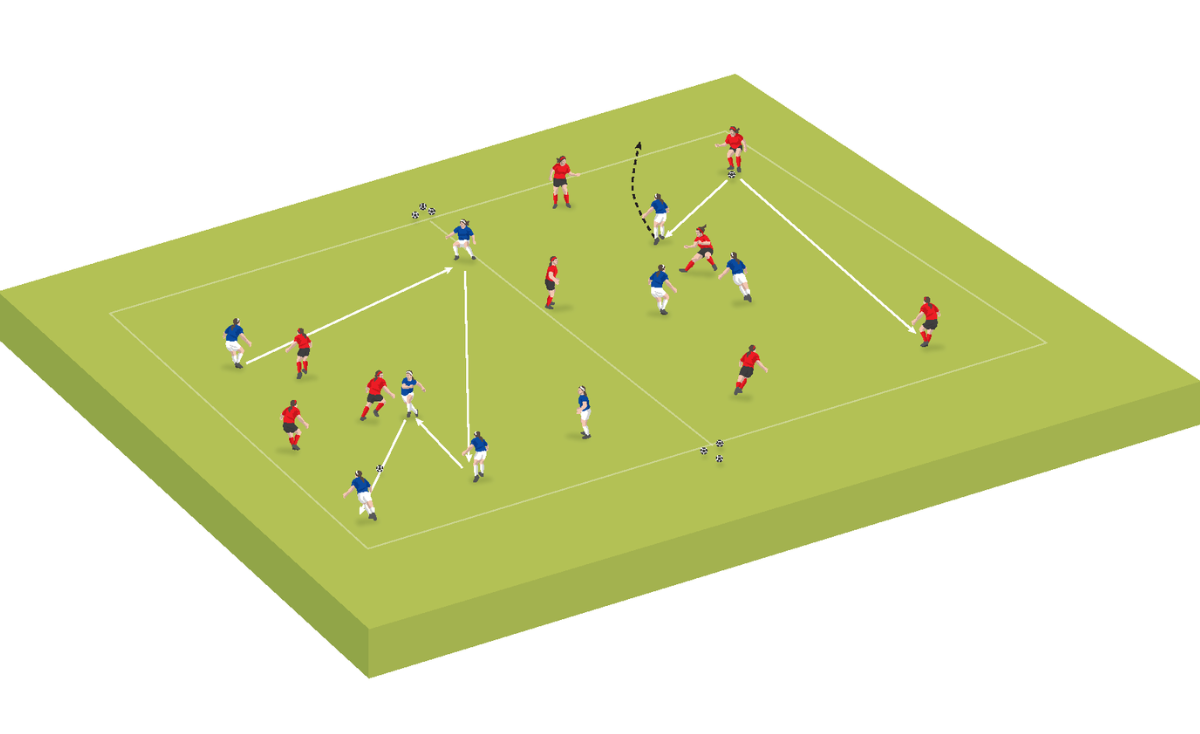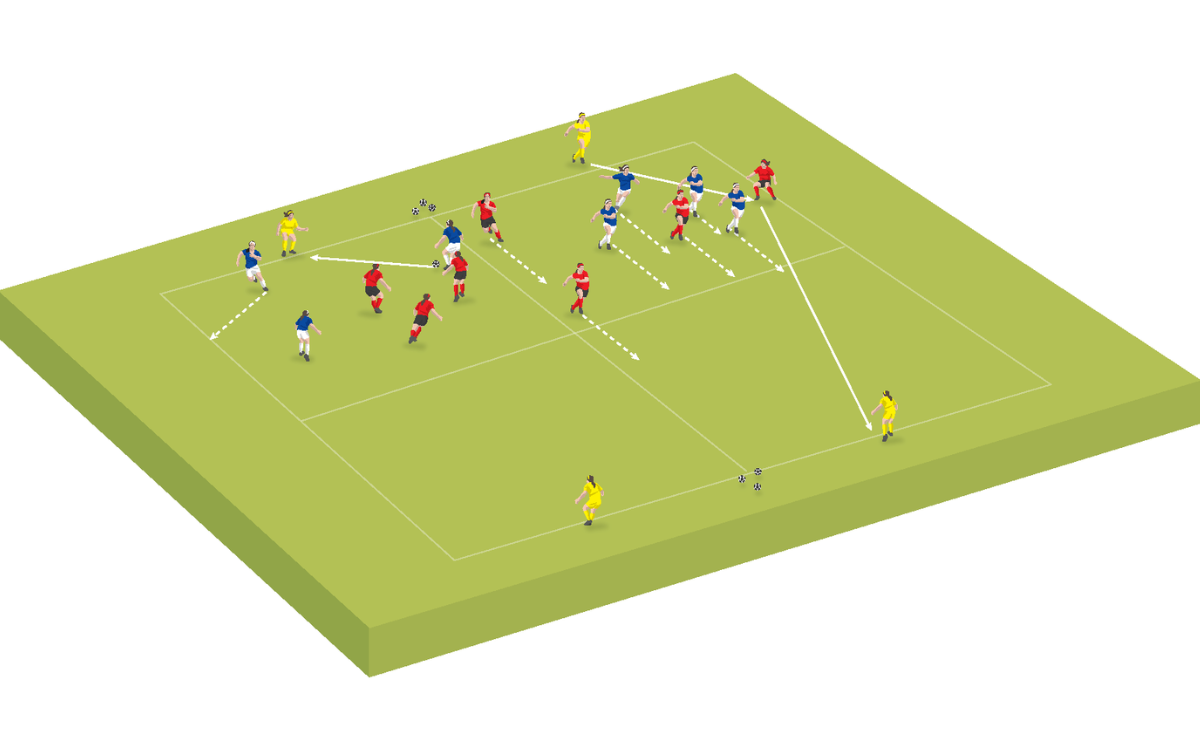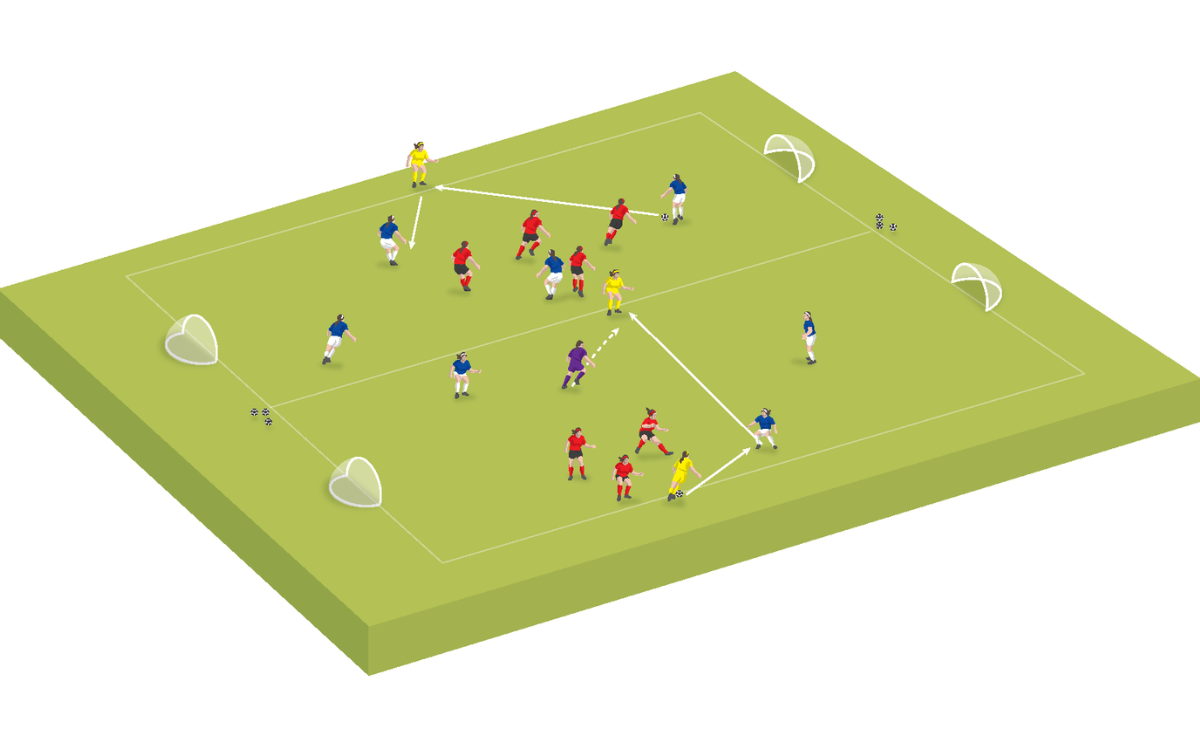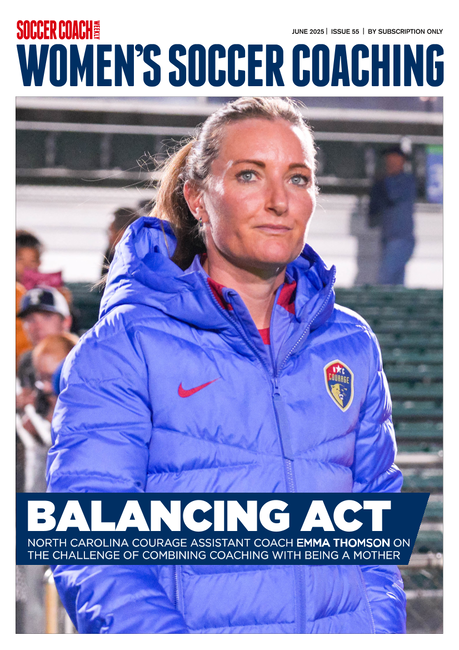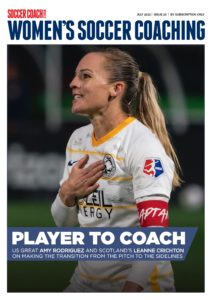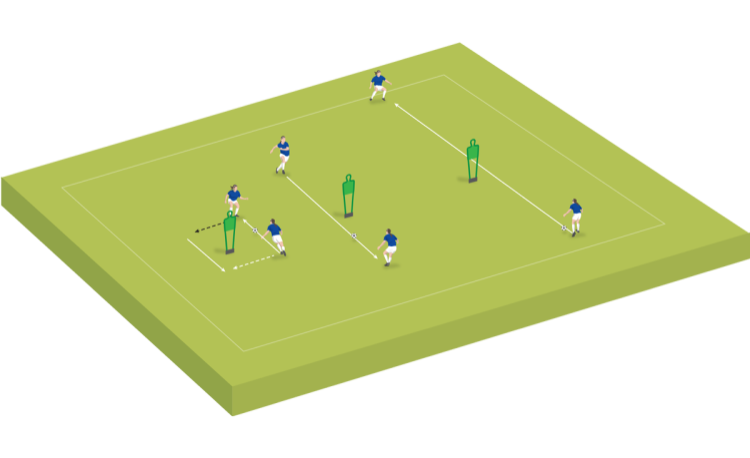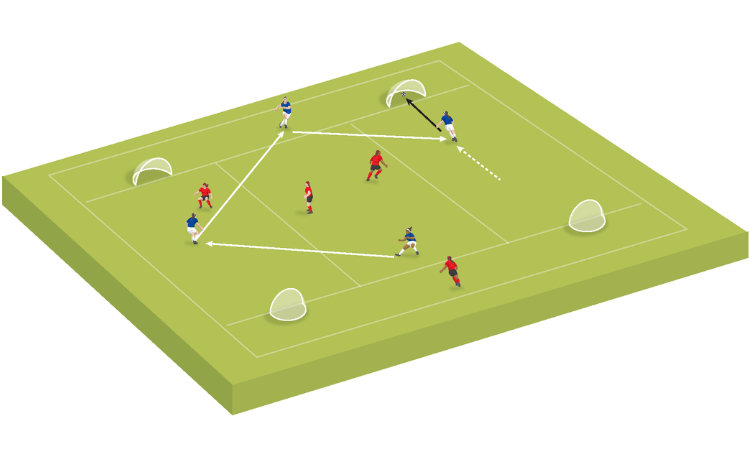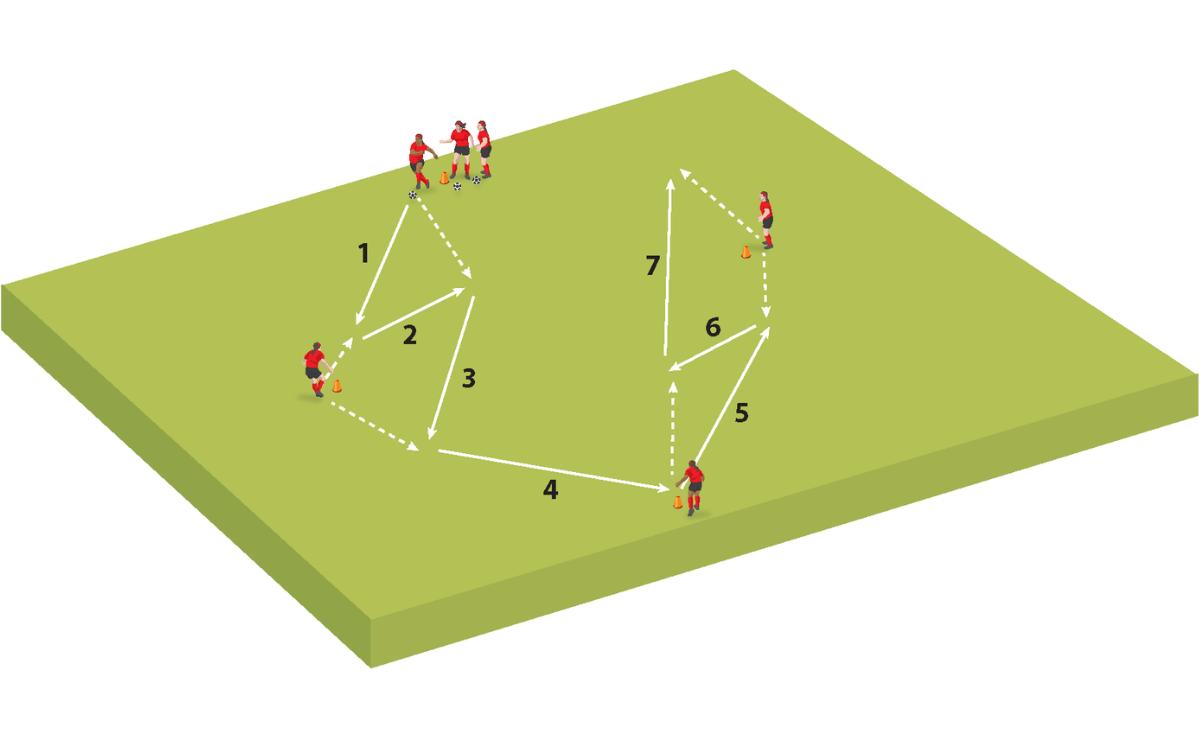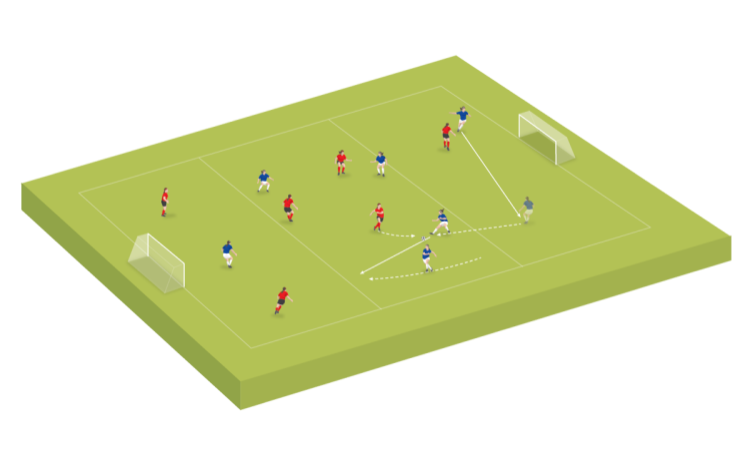Mastering the switch
A three-part session which works on switching the point of attack. Session structure: Warm-up, Practice, Small-sided game
Warm-up
WHY USE IT
Starting with a rondo allows players to mentally prepare for the session, ensuring they are committing to all four moments of the game: in-possession, negative transition, out-of-possession and positive transition.
Set-up
Mark out two equal squares, relative to the age, ability and number of players. Divide players into two teams, each starting in separate squares. Place balls at the corners of the two squares, and, ideally, have two coaches to feed balls in to keep the activity fast.
HOW TO play
Each bout lasts between 90 seconds and two minutes. At the start, each team sends two or three defenders into the opponent’s square.
For the first activity, attackers get one point for four successful passes. Defenders get two points for dribbling out of the square, and one point for passing to each other. At the end of the bout, players go back to their team and add up attacking and defending scores.
progressions & ADAPTATIONS
-
Add a small box in the middle of each square. Now, attackers can receive and play out of a different side of the central box. for an additional three points.
-
If too hard, make the square bigger or reduce number of defenders. Defenders have to hold a bib between them to stay connected.
-
If too easy, implement a rule that, after receiving in the middle box, you can’t receive again there straight away. This forces rotation of players.
-
Place cones on the outside of the larger box. Each time a player receives and passes they must relocate the cone to a different side. This forces repositioning and ’switching’, as you are preventing passes going straight back to the same player.
COACHING POINTS
Attacking
• Reposition often, focus on open body shape and hips.
• Scan continuously.
• Pass to the correct foot: where is the pressure?
• Receive and play away from pressure (back foot), with limited touches.
Defending
• Pressure together.
Reinforce game model – all four moments of the game
• Counter-press: when you lose the ball, press/repress together to prevent successful transition.
-
Divide players into groups, each starting in separate squares
-
The coach plays a ball into each team, and each team sends 2-3 players to defend in the opposite square
-
Defenders earn two points for winning possession and dribbling out of the square, or one point for passing to each other
-
Attackers get a point for four successful passes
Practice
WHY USE IT
This is a progression from a rondo. It is more game realistic, with the spacing/option to switch play.
Set-up
Mark out four connected squares, relative to the age, ability and number of players. Place balls at the corners of the two squares and, ideally, have two coaches to feed balls in to keep the activity fast. Divide players into two equal teams, plus four target players.
HOW TO play
Each bout lasts three minutes, or can be played as a race to 20 points. Two target players start at each end (one per square). Divide each team into two, with equal numbers (3v3 or 4v4), starting in each of the top two squares.
Every pass is worth one point, promoting possession and patience. A pass over the halfway line to the opposite target player is worth three points. Everyone must be in the same square before switching.
progressions & ADAPTATIONS
Progressions
- Target-to-target switch = 2 points; or a pass to a player that can immediately switch = 1 point
- Players can only play to target twice in one possession before switching.
Adaptations – too hard
- Add an additional neutral player.
- Players cannot press/tackle target players.
Adaptations – too easy
- Target players have limited touches (1 or 2). This means targets have to think quicker, and players have to position/reposition faster to support.
- First time switches = 5 points. This promotes quicker body adjustment, scanning and challenges technical ability.
- Can only switch for 3 points in two passes or less, otherwise it is only 1.
COACHING POINTS
Attacking
- Reposition often, focus on open body shape and hips.
- Scan continuously – make a decision before you receive.
- Pass to the correct foot: where is the pressure?
- Receive and play away from pressure (back foot), with limited touches.
Counter coaching points (defending)
- Pressure together.
Related Files
-
Divide players into two teams, in two separate channels, with target players starting at the
top and bottom of each channel
- Teams earn a point for each successful pass
-
Teams earn three points for switching play to the opposite target player. All players must be in one half before switching
Small-sided game
WHY USE IT
This practice is more game realistic (directional, opposition, decisions). Rules/points awarded bring out the repetition of desired action (switching play). Positions (e.g. attacking full-backs) are added to reinforce style of play.
Set-up
Mark out two small-sided fields, with mini goals. Select three neutral players (Yellows) to act as wide players – one plays in between both fields to test the central players’ awareness before passing. A ’negative neutral’ (in all purple here) is added for difficulty – this player can only defend.
HOW TO play
Play two regular small-sided games (3v3/4v4), with wide neutrals, and go through progressions if needed/wanted, based on the challenge level.
Each bout lasts five or six minutes, or until the negative neutral steals the ball seven times.
progressions & ADAPTATIONS
Progressions
-
Neutral players play against each other (a game within a game, collect scores at the end). Each time they receive, they get 1 point, or 2 points for an assist or a goal. This encourages them to receive and be positive.
-
Neutral-to-neutral pass = 1 point.
-
Neutral-to-neutral pass and a goal = 3 points.
-
Full-back to full-back goal = 5 points.
Adaptations – too hard
-
Add additional neutrals.
-
Wide players are unopposed on the outside, but can’t score.
Adaptations – too easy
- Play the same game without wide neutrals, just have wide channels where players can play in and the rewards can still count.
COACHING POINTS
Attacking
-
Reposition often, focus on open body shape and hips.
-
Team shape: width/depth/height.
-
Scan continuously – make a decision before you receive. Check wide player is available.
-
Pass to the correct foot: where is the pressure?
-
Receive and play away from pressure (back foot), within limited touches.
-
Various technical execution of first-time switches.
-
Full-backs receive the switch as high as possible.
-
Weak side full-back has decision as to whether to position themselves wide or inverted.
-
Divide players into four teams of 4 or 5, with three neutral players and a negative neutral player
-
Teams play on adjacent pitches, with neutral players positioned on each touchline. The middle neutral player plays for both pitches
-
Normal match rules apply, but the negative neutral (purple) can only play for the out-of-possession teams
-
Each bout is over after five or six minutes or when the negative neutral wins possession seven times
Newsletter Sign Up
Newsletter Sign Up
Discover the simple way to become a more effective, more successful soccer coach
In a recent survey 89% of subscribers said Women's Soccer Coaching makes them more confident, 91% said Women's Soccer Coaching makes them a more effective coach and 93% said Women's Soccer Coaching makes them more inspired.
*includes 3 coaching manuals
Get Inspired
All the latest techniques and approaches
Women's Soccer Coaching offers proven and easy to use soccer drills, coaching sessions, practice plans, small-sided games, warm-ups, training tips and advice.
We've been at the cutting edge of soccer coaching since we launched Soccer Coach Weekly in 2007, creating resources for the grassroots youth coach, following best practice from around the world and insights from the professional game.
